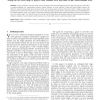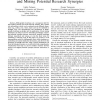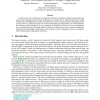TVCG
2012
12 years 5 months ago
2012
—We present a new approach for time-varying graph drawing that achieves both spatiotemporal coherence and multifocus+context visualization in a single framework. Our approach uti...
TVCG
2012
12 years 5 months ago
2012
—Graph visualization has been widely used to understand and present both global structural and local adjacency information in relational datasets (e.g., transportation networks, ...
ASUNAM
2011
IEEE
13 years 3 months ago
2011
IEEE
—Bibliographic databases are a prosperous field for data mining research and social network analysis. They contain rich information, which can be analyzed across different dimen...
GRAPHICSINTERFACE
2011
13 years 6 months ago
2011
People generally remember locations in visual spaces with respect to spatial features and landmarks. Geographical maps provide many spatial features and hence are easy to remember...
AVI
2006
14 years 4 months ago
2006
Our goal is to define a list of tasks for graph visualization that has enough detail and specificity to be useful to designers who want to improve their system and to evaluators w...
GD
2009
Springer
14 years 7 months ago
2009
Springer
Traditional network visualization tools inherently suffer from scalability problems, particularly when such tools are interactive and web-based. In this paper we introduce WiGis �...
APWEB
2005
Springer
14 years 8 months ago
2005
Springer
This paper presents a new method for visualizing and navigating huge graphs. The main feature of this method is that it applies Level-Of-Detail (LOD) strategy to graph visualizati...
ACSC
2005
IEEE
14 years 8 months ago
2005
IEEE
Many classical graph visualization algorithms have already been developed over the past decades. However, these algorithms face difficulties in practice, such as the overlapping n...
CIKM
2007
Springer
14 years 9 months ago
2007
Springer
We present Paged Graph Visualization (PGV), a new semiautonomous tool for RDF data exploration and visualization. PGV consists of two main components: a) the “PGV explorer” an...
SAMT
2009
Springer
14 years 9 months ago
2009
Springer
Abstract. Understanding relationships and commonalities between digital contents based on metadata is a difficult user task that requires sophisticated presentation forms. In this ...



